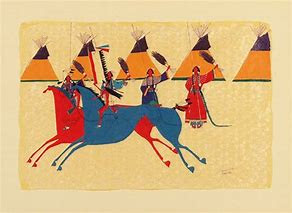Dakota Sioux Picture Writing
Among many tribes pictures were used for recording matters of importance. Many Sioux chiefs have written the story of their life in pictures. They took several large sheets of paper and gummed the edges together so as to make one long strip. Upon this, they made pictures representing the important incidents in their lives. Thus in one picture was shown where, as a boy, the artist shot his first deer; in another
was represented his first hunting party; in another, how he went on the war-path to gain the name of brave; in another, where he danced the sun dance; again, how he went to Washington to see the white men's officers, on business.
was represented his first hunting party; in another, how he went on the war-path to gain the name of brave; in another, where he danced the sun dance; again, how he went to Washington to see the white men's officers, on business.
The most important record made by the Sioux is the Dakota Calendar. More than a century ago a Sioux Indian determined to keep a count of the years and of their happenings. So he began a record which was called a “winter count,” where the events of the different years were shown by pictures. His idea became popular, and a number of these winter counts were begun by other Indians. The most important of these is one which has been called the Dakota Calendar. It belonged for a long time to an Indian named Lone Dog. The one he had was a copy on cloth from a still older one, which had been made upon a buffalo skin. This count appears to have begun about the year 1800.
Each year its maker selected some important event, by which the year was to be remembered, and made a picture for it. The first five or six pictures run in a nearly straight line to the left; the line of pictures then coils around and around this, the last picture always being added to the end of the coiled line. The pictures are in black and red, and while rudely drawn, most of them can be easily recognized. In 1801 the
Sioux had a terrible attack of smallpox, and many of them died; the picture for the year is a man covered with red spots. Whooping-cough is a disease of which white people have little fear, but it is sometimes very destructive to Indians; in 1813 it was among the Sioux, and the picture for that year was a man coughing, as shown by lines diverging from in front of his mouth. In 1840 the Sioux made a treaty of peace with the Cheyennes; the picture shows two hands extended for a friendly grasp. In 1869 there was a total eclipse of the sun, which is represented by a blackened sun and two stars in red: “The stars were seen in the daytime.” In 1833 was the famous display of meteors or falling stars, which was witnessed in all parts of the United States, causing great excitement; many white people believed that it portended the destruction of the world. This star shower was noticed by the Sioux keeper of the winter count, and is represented by a black moon and a lot of red stars represented as falling. You can pick out these different figures in the picture, which represents Lone Dog's winter count, or the Dakota Calendar as it would look on a buffalo hide.
Each year its maker selected some important event, by which the year was to be remembered, and made a picture for it. The first five or six pictures run in a nearly straight line to the left; the line of pictures then coils around and around this, the last picture always being added to the end of the coiled line. The pictures are in black and red, and while rudely drawn, most of them can be easily recognized. In 1801 the
Sioux had a terrible attack of smallpox, and many of them died; the picture for the year is a man covered with red spots. Whooping-cough is a disease of which white people have little fear, but it is sometimes very destructive to Indians; in 1813 it was among the Sioux, and the picture for that year was a man coughing, as shown by lines diverging from in front of his mouth. In 1840 the Sioux made a treaty of peace with the Cheyennes; the picture shows two hands extended for a friendly grasp. In 1869 there was a total eclipse of the sun, which is represented by a blackened sun and two stars in red: “The stars were seen in the daytime.” In 1833 was the famous display of meteors or falling stars, which was witnessed in all parts of the United States, causing great excitement; many white people believed that it portended the destruction of the world. This star shower was noticed by the Sioux keeper of the winter count, and is represented by a black moon and a lot of red stars represented as falling. You can pick out these different figures in the picture, which represents Lone Dog's winter count, or the Dakota Calendar as it would look on a buffalo hide.

